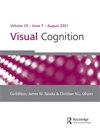Investigating the automaticity of links between body perception and trait concepts
IF 1.7
4区 心理学
Q3 PSYCHOLOGY, EXPERIMENTAL
引用次数: 0
Abstract
ABSTRACTSocial cognition has been argued to rely on automatic mechanisms, but little is known about how automatically the processing of body shapes is linked to other social processes, such as trait inference. In three pre-registered experiments, we tested the automaticity of links between body shape perception and trait inference by manipulating cognitive load during a response-competition task. In Experiment 1 (N = 52), participants categorised body shapes in the context of compatible or incompatible trait words, under high and low cognitive load. Bayesian multi-level modelling of reaction times indicated that interference caused by the compatibility of trait cues was insensitive to concurrent demands placed on working memory resources. These findings indicate that the linking of body shapes and traits is resource-light and more “automatic” in this sense. In Experiment 2 (N = 39) and 3 (N = 70), we asked participants to categorise trait words in the context of task-irrelevant body shapes. Under these conditions, no evidence of interference was found, regardless of concurrent load. These results suggest that while body shapes and trait concepts can be linked in an automatic manner, such processes are sensitive to wider contextual factors, such as the order in which information is presented.KEYWORDS: Social cognitionbody perceptionautomaticitytrait inferencecognitive load Disclosure statementNo potential conflict of interest was reported by the author(s).研究身体知觉与特质概念之间联系的自动性
摘要社会认知一直被认为依赖于自动机制,但人们对身体形状的自动加工如何与其他社会过程(如特征推断)联系在一起知之甚少。在三个预注册实验中,我们通过在反应-竞争任务中操纵认知负荷来测试体型感知与特质推断之间联系的自动性。在实验1 (N = 52)中,被试分别在高认知负荷和低认知负荷下,在兼容或不兼容特质词的语境下对体型进行分类。贝叶斯多层次反应时间模型表明,特质线索的相容性引起的干扰对工作记忆资源的并发需求不敏感。这些发现表明,从这个意义上说,体型和特征之间的联系是资源较少的,而且更“自动”。在实验2 (N = 39)和实验3 (N = 70)中,我们要求参与者在与任务无关的体型背景下对特征词进行分类。在这些条件下,无论并发负载如何,都没有发现干扰的证据。这些结果表明,虽然体型和特征概念可以以一种自动的方式联系起来,但这种过程对更广泛的背景因素很敏感,比如信息呈现的顺序。关键词:社会认知、身体知觉、自动性、特质推理、认知负荷披露声明作者未发现潜在利益冲突。
本文章由计算机程序翻译,如有差异,请以英文原文为准。
求助全文
约1分钟内获得全文
求助全文
来源期刊

VISUAL COGNITION
PSYCHOLOGY, EXPERIMENTAL-
CiteScore
4.20
自引率
10.00%
发文量
29
期刊介绍:
Visual Cognition publishes new empirical research that increases theoretical understanding of human visual cognition. Studies may be concerned with any aspect of visual cognition such as object, face, and scene recognition; visual attention and search; short-term and long-term visual memory; visual word recognition and reading; eye movement control and active vision; and visual imagery. The journal is devoted to research at the interface of visual perception and cognition and does not typically publish papers in areas of perception or psychophysics that are covered by the many publication outlets for those topics.
 求助内容:
求助内容: 应助结果提醒方式:
应助结果提醒方式:


